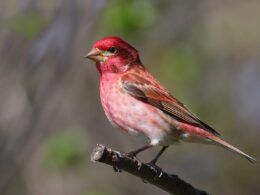Last Updated on January 12, 2024 by Greg Gillson
Did you see a brightly-colored red bird, orange bird, or yellow bird in Michigan and wonder what is was?
This page is for you!
This article shows you photos and identification of some of the most common birds in Michigan based on color.
The list of birds found in Michigan includes over 435 species. So, I can’t show you all of them. I’m going to assume that you saw a common bird of this color, but you certainly could have seen something less common, or even rare!
Shape (including the shape of the bill) and size are often more helpful in starting to identify a bird than the color. In fact, most birds in North American can be easily identified with a black-and-white photo!
Many birds are multi-colored, so that it may be hard to pick out a dominant color. Males and females may be colored quite differently. And some color patterns are similar among otherwise dissimilar species.
Nevertheless, I’m going to try to pick out some of the birds that you are most likely to see in backyards or towns. And I’ll show a few others that I get asked about a lot.
The birds with a noticeable amount of red on them in Michigan covered in this article are:
- American Robin
- Northern Cardinal
- House Finch
- Rose-breasted Grosbeak
- Ruby-throated Hummingbird
- Scarlet Tanager
The birds with a noticeable amount of orange on them in Michigan covered in this article are:
- Barn Swallow
- Baltimore Oriole
- Red-breasted Nuthatch
- American Redstart
- Eastern Towhee
- Cooper’s Hawk
- Brown Thrasher
- American Kestrel
- Wood Thrush
The birds with a noticeable amount of yellow on them, including lots of yellow and black birds, in Michigan covered in this article are:
- American Goldfinch
- Northern Flicker
- Cedar Waxwing
- Common Yellowthroat
- Yellow Warbler
- Yellow-rumped Warbler
- Great Crested Flycatcher
- Nashville Warbler
- Black-throated Green Warbler
- Pine Siskin
- Palm Warbler
- Eastern Meadowlark
- Yellow-throated Vireo
- Pine Warbler
Red birds of Michigan
Birds get the red, orange, and yellow in their feathers from carotenoids in the fruit, seeds, and plants they eat (source).
These carotenoid colors combine with melanin to form an infinite range of red feathers–pink, rusty, scarlet, violet, red-orange.
The following are red birds that you are most likely to see in Michigan.
American Robin
These are familiar lawn birds with red breasts.
 |
| American Robin. Greg Gillson. |
Male American Robins are brownish-gray above with a brick red breast. Females are paler orange below and paler gray above.
They are widespread in open country with scattered deciduous trees, residential areas.
American Robins are summer residents on the Upper Peninsula of Michigan and and year-round residents on the Lower Peninsula of Michigan.
Northern Cardinal
These are one of the most common backyard birds in the eastern United States. Their bright red color and unique head profile makes them instantly identifiable to most people–whether they are bird watchers or not!

Males of these large seed eaters are bright red with a black face and red crest.
Females replace most of the red with brown, The bill is large and orange.
These birds are found in woodlands, stream edges, residential areas.
Northern Cardinals are year-round residents on the Lower Peninsula of Michigan, they are almost absent from the Upper Peninsula, but year-round residents on the southern part of the Upper Peninsula of Michigan.
House Finch
When people ask about a bird with a red head at their feeder, it is usually this bird.
 |
| Male House Finch. Greg Gillson. |
Males of this dusty brown striped finch have red limited to the head (specifically the forehead and eyebrow), breast (chest), and rump. The red coloration tends toward orangish, and may rarely be yellowish.
Females are streaked, similar to the males but without red. They lack any strong pattern on the face and head.
Note the small round head and curved upper ridge on the bill.
Some people call these red-headed sparrows. Sparrows and finches are similar, but in general, male finches are brighter than the females and tend to hang out more in trees. Sparrow genders are usually quite similar in coloration and tend to feed mostly on the ground.
These birds are common in residential areas, especially at bird feeders. In the West more widespread in arid regions near water.
House Finches are year-round residents on the Lower Peninsula of Michigan, absent on the Upper Peninsula.
Rose-breasted Grosbeak
These birds with the red breast and huge pink bill sing beautiful robin-like songs from the tops of trees.
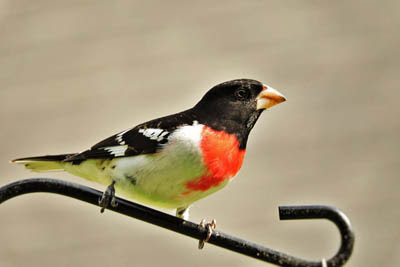 |
| Male Rose-breasted Grosbeak. Susan Killian. Pixabay. |
Males have black hood and upper parts. White under parts. Large white wing patches. Huge pink bill. Inverted bright red triangle on the breast.
Females are brown above, face with broad stripes, white throat. The under parts are buff with many thin brown streaks. Pale bill.
These birds inhabit deciduous and mixed forests. Shade trees in town. Come to feeders.
Rose-breasted Grosbeaks are summer residents throughout Michigan.
Ruby-throated Hummingbird
These red-throated birds are the only hummingbird nesting in the eastern United States.
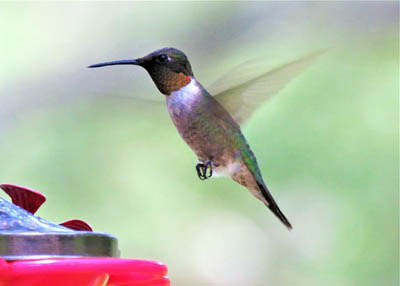 |
| Male Ruby-throated Hummingbird. GeorgeB2. Pixabay. |
Males are dark green above and on the belly. They have a white upper chest. The throat is ruby-red.
Females are green above, white below, including white throat.
These birds are found in woodland edges, residential yards. Readily come to hummingbird feeders.
Ruby-throated Hummingbirds are summer residents throughout Michigan.
Scarlet Tanager
A brilliant red and black bird!
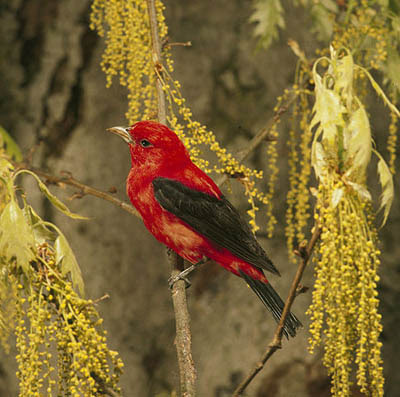 |
| Male Scarlet Tanager. USF&WS. Public Domain. |
Males are unmistakable with brilliant red with black wings and tail.
Females are olive-green above, darker wings and tail, yellower under parts. Pale bill.
These birds live in deciduous woods.
Scarlet Tanagers are summer residents throughout Michigan.
Orange birds of Michigan
True orange-colored birds are not that common. Many birds that I have here are paler rusty.
The common pattern is an orange body and black or brown wings and tail. Another common pattern is for the orange to be restricted to the under parts.
The following are orange birds that you are most likely to see in Michigan.
Barn Swallow
These orange-bellied birds are a familiar sight across North America in summer.
 |
| Barn Swallow. Greg Gillson. |
These birds are purple-blue above with orange under parts and long forked tails. The color of the underparts in winter or on females are often cinnamon or buff-colored, but breeding males can be brighter orange-red.
These birds swoop low over fields and wetlands at lower elevations. They may build their mud nests in rafters on porches, garages, or other out-buildings.
Barn Swallows are summer residents throughout Michigan.
Baltimore Oriole
These bright orange and black birds are fairly common breeders in wooded areas in the East.
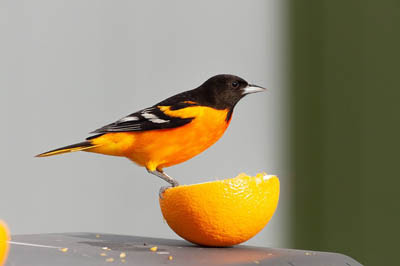 |
| Baltimore Oriole. Michael McGough. Pixabay. |
Males are have a black hood and back. Wings black with white patches. Tail black with orange sides to the base. Bright orange under parts.
Females are similar to males, but more olive above, less black. Immature birds for their first year or more are olive above orangish-yellow on the breast, fading to yellow on the belly. Two white wing bars.
These birds are common in deciduous woods, shade trees.
Baltimore Orioles are summer residents throughout Michigan.
Red-breasted Nuthatch
These active little red-breasted birds crawls all around on the trunk and big branches of conifers. They search crevices in the bark for insect food.
 |
| Red-breasted Nuthatch. Greg Gillson. |
These tiny birds have blue-gray backs and a black line through a white face. Some males can have quite bright rusty red under parts. Some females can have quite pale buff-colored under parts. Most birds show an orange-cinnamon breast color.
Found nearly exclusively in conifers. Readily come to feeders.
Red-breasted Nuthatches are year-round residents throughout most of Michigan, winter visitors only in southern Michigan.
American Redstart
In flight these small warblers flash orange or yellow in the wing and based of the tail.
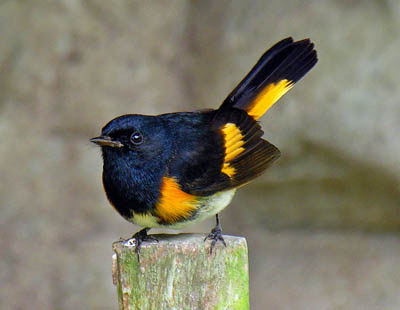 |
| American Redstart. Dennis Jarvis. Flikr. CC BY-SA 2.0 |
Males are black above, white on the belly. They have bright orange patches on side of breast, wings, and base of the tail.
Females are grayer, especially on the head. The orange of males is replaced by yellow on the females.
These birds are found in regenerating woods after a clear cut, and willow tangles along streams.
American Redstarts are summer residents throughout Michigan.
Eastern Towhee
These birds with rusty-orange sides like to hide in dense bushes.
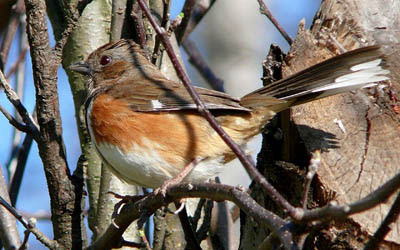 |
| Female Eastern Towhee. Skeeze. Pixabay. |
Males are black above with white wing patch, white tail corners. The sides are rusty. The belly white. Eyes variable: brown, red, orange, white, tending toward whiter southward.
Females are similar, but upper parts brown.
These birds are found in forest understory, dense brush, backyard hedges. Come to feeders.
Eastern Towhees are summer resident throughout most of Michigan, absent in some parts of the Upper Peninsula.
Cooper’s Hawk
These crow-sized hawks with reddish orange bars on the under parts may show up in fall or winter to hunt birds at your feeder. Oh no!
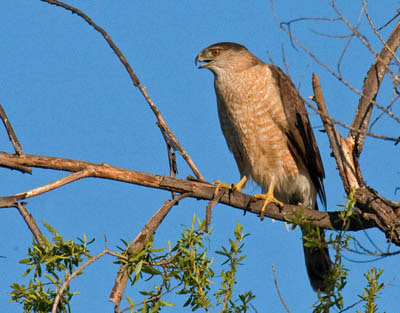 |
| Cooper’s Hawk. Greg Gillson. |
Adults with long gray and black banded tail. Dark gray above and cap on head. Under parts barred with rusty orange.
Immatures similar, brownish, streaked with brown on under parts.
Found in forests and woodlands, residential shade trees.
Cooper’s Hawks are summer residents throughout Michigan, year-round residents in southern Michigan.
Brown Thrasher
These are rather large rusty-orange songbirds.
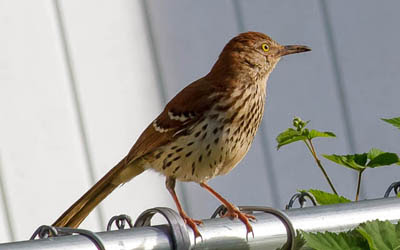 |
| Brown Thrasher. Linda Jones CC0. |
The upper parts of these birds is colored rusty-brown to orange. They show two white wing bars. Under parts are buff with heavy reddish-brown streaking.
These birds live in woodland edges and mature backyard landscaping.
Brown Thrashers are summer residents throughout Michigan.
American Kestrel
These are the familiar small rusty-orange falcons sitting on power lines on the edge of the highway, or hunting and hovering over the median strip.

Females are rusty orange barred with black on their back wings and tail. The under parts are buff with black spots. The head shows two facial stripes.
Males have blue-gray backs and rufous tail is unmarked except for black tail band.
These birds are found in open country, farms, pastures with perches.
American Kestrels are summer residents throughout Michigan.
Wood Thrush
These spotted birds with the orange-brown upper parts tend to hide in understory trees and on the forest floor.
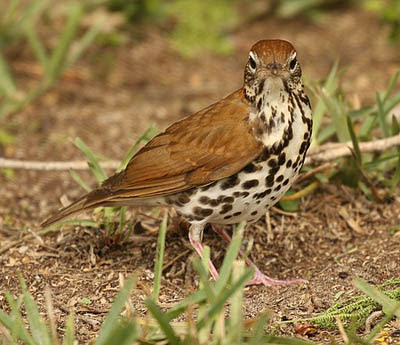 |
| Wood Thrush. Tony Castro. CC BY-SA 4.0 |
These birds are reddish brown on the upper parts, especially rusty orange on the crown and upper back. White eye ring. Large heavy black spots on the under parts.
They live in deciduous and mixed woods. Spend much time on the ground, shuffling through the leaf litter.
Wood Thrushes are summer residents throughout Michigan.
Yellow birds of Michigan
Yellow is a common bird color! Often it is mixed with black and white plumage in birds.
Many birds with darker upper parts have yellow breast or belly.
The following are yellow birds you are most likely to see in Michigan.
American Goldfinch
These small little birds are bright yellow and black.
 |
| American Goldfinch. Greg Gillson. |
Males are bright lemon yellow with black and white wings and tail, black cap. White under tail coverts. Pink bill.
Females are duller yellow below and brownish above. Lack black cap.
Winter birds are pale brown or gray, a touch of yellow on the throat of males.
These are birds of open country, fields with saplings, clear cuts, residential areas. They avoid dense forests, mountains, deserts. They visit feeders.
American Goldfinches are year-round residents throughout most of Michigan, summer residents only in northern Lower Peninsula and summer residents only in eastern Upper Peninsula of Michigan.
Northern Flicker
These woodpeckers spend much time eating ants on the ground.
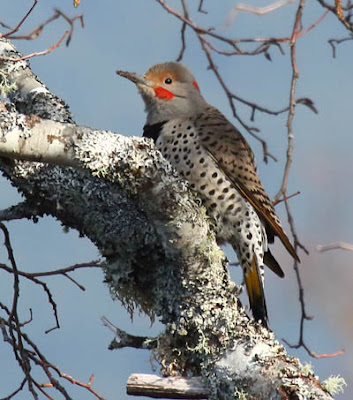 |
| Northern Flicker. Greg Gillson. |
These birds are larger than robins with brown and black barred upper parts. The underparts are pink with round black spots. There is a black crescent across the chest. When they fly away from you they reveal a large white rump.
Western birds have salmon-red under wings and under tail. Those in the East are colored yellow. The male face differs between the two populations–black whisker on the eastern birds, red whisker on western birds. Intergrades from overlap on Great Plains common. These may show male facial characteristics of both populations, or yellow-orange flight feathers.
These birds live in open woods with bare ground for foraging, residential yards.
Northern Flickers year-round residents on the Lower Peninsula, summer residents only on the Upper Peninsula of Michigan.
Cedar Waxwing
These crested birds with yellow band on the end of the tail are often found in flocks. They eat flying insects in summer, fruit and berries the rest of the year.
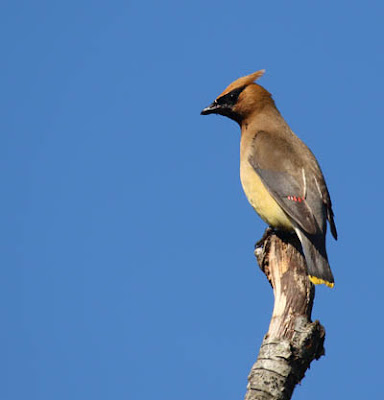 |
| Cedar Waxwing. Greg Gillson. |
These birds are fawn-brown above, with dark gray wings and tail. They have a black mask and wispy crest. The belly is yellow. The wings have waxy red drops on the end of the tertials. The end of the tail has a brilliant yellow tail band.
They are found in open habitats with berries, including juniper woodlands and towns in winter.
Cedar Waxwings are year-round residents throughout Michigan.
Common Yellowthroat
These buttery yellow birds are abundant in the marsh vegetation.
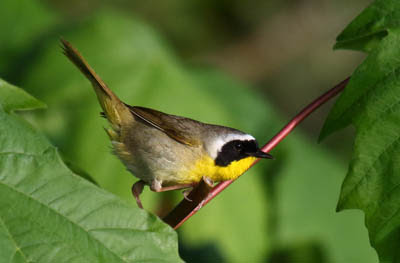 |
| Male Common Yellowthroat. Greg Gillson. |
These skulkers have bright yellow throats and yellow undertail coverts. Males have a black domino mask edged broadly in white, which females lack. Upperparts are dull olive-green.
Immature males in fall show a shadowed black mask.
Found in damp situations and heavy deciduous brambles following clear cuts.
Common Yellowthroats are summer residents throughout Michigan.
Yellow Warbler
The golden yellow sun packed all into one little bird! Appear to be all-yellow birds.
 |
| Yellow Warbler. Greg Gillson. |
Some populations are bright yellow, some tend toward greenish on upper parts, some more golden. Yellow internal tail corners in flight.
Males with red breast streaking, again, variable by population.
Females somewhat to much paler yellow, some greenish, some whitish. Lack red streaks.
These birds are found in willow thickets on the edge of wetlands and ditches, stream sides in arid regions.
Yellow Warblers are summer residents throughout Michigan.
Yellow-rumped Warbler
These are abundant warblers across North America. Affectionately called “butter butts” by many birders, because of their bright yellow rumps that flash in flight.
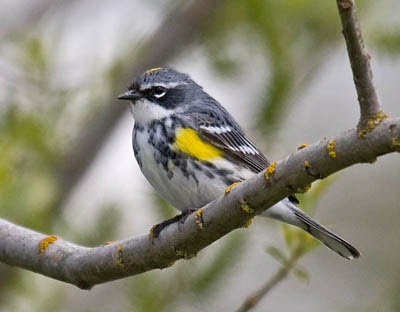 |
| Breeding male Yellow-rumped (Myrtle) Warbler. Greg Gillson. |
Western form (Audubon’s) with bright yellow throat and yellow rump. Large white wing patch.
Northern and Eastern form (Myrtle) with white throat, yellow rump, and two white wing bars.
Winter birds are dull gray brown, with bright yellow rump. Throat may be cream colored or white. Often difficult to tell the two forms apart in winter.
 |
| Winter Yellow-rumped Warbler. Greg Gillson. |
Breed in mountain or boreal conifers. Widespread in migration. Winter in low river bottoms, open weedy deciduous areas. Rarely come to feeders in winter.
Yellow-rumped Warblers are summer residents on the Upper Peninsula and northern parts of the Lower Peninsula of Michigan. Yellow-rumped Warblers are winter visitors in southern Michigan, and spring and fall migrants throughout.
Great Crested Flycatcher
These flycatchers have long tails and big heads with big bill and bright yellow belly.
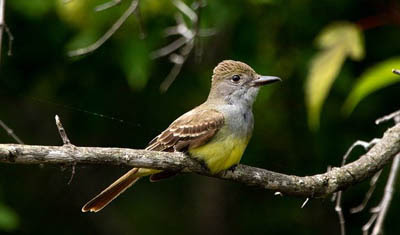 |
| Great Crested Flycatcher. Simard Francois. Pixabay. |
These birds are gray on the face and breast, brownish on rest of upper parts. Bright lemon yellow belly. The under side of the tail and some feathers of the wing are cinnamon colored.
These birds stay in the canopy of open woods.
Great Crested Flycatchers are summer residents throughout Michigan.
Nashville Warbler
These birds with the bright yellow underparts do a good job of hiding!
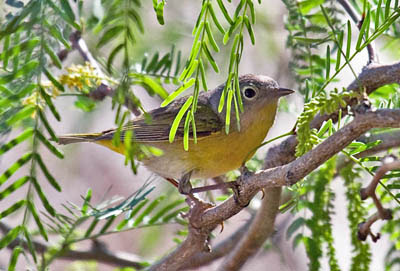 |
| Nashville Warbler. Greg Gillson. |
These birds are gray above. The throat and breast and under tail coverts are bright lemon yellow. The belly is white. They have a complete white eye ring.
Females are just a bit paler than males.
These birds are found in re-growing clear cuts, and understory brush in open woods.
Nashville Warblers are summer residents in the Upper Peninsula and summer residents in northern Lower Peninsula of Michigan. They are spring and fall migrants only in southern Michigan.
Black-throated Green Warbler
Look for these birds with the yellow faces singing high up in the trees in spring.
 |
| Black-throated Green Warbler. Madeline Allen. Pixabay. |
Males in spring have green back and crown, black throat, circling a bright yellow face.
Females and immatures in fall have a white throat. Greenish ear patch.
Found in many forest types, conifers, mixed forests, and cypress.
Black-throated Green Warblers are summer residents throughout most of Michigan, spring and fall migrants only in southern Michigan.
Pine Siskin
These small brown-streaked birds are relatives of the goldfinches. But you would never know it until they fly and sport yellow wing stripes and tail base. Usually in flocks.
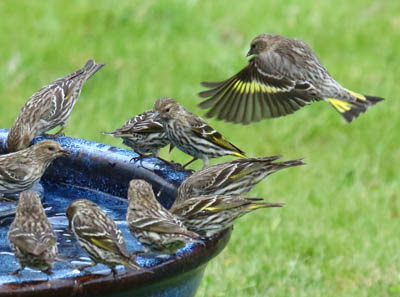 |
| Pine Siskin. Greg Gillson. |
These birds are streaked brown. In flight they have a yellow stripe down the length of the wing. The sides of the base of the tail is also yellow. Some birds are paler, some darker, others brighter yellow, others duller.
These birds are found in summer in northern conifer woods. Irregularly irrupt hundreds of miles southward. Frequent at feeders.
Pine Siskins are year-round residents on the Upper Peninsula and northern parts of the Lower Peninsula of Michigan. Pine Siskins are winter visitors only in southern Michigan.
Palm Warbler
These rather drab birds have bright yellow under tail coverts. They tend to spend much time on the ground in disturbed soils. They constantly bob their tail up and down.
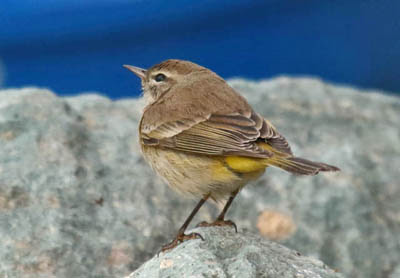 |
| Winter Palm Warbler. Greg Gillson. |
Breeding birds are rather gray with yellow throat, vent and under tail coverts. White eyebrow stripe. Chestnut cap. Eastern birds tend to be more yellowish on the breast.
In winter birds are very pale, but with yellow under tail.
They nest in bogs within boreal forests. They like similar habitat at other times of year: open land with isolated scrubby trees or bushes, including coastal scrub.
Palm Warblers are summer residents in the Upper Peninsula of Michigan, spring and fall migrants only through the Lower Peninsula of Michigan.
Eastern Meadowlark
These pale brown birds with the brilliant yellow breasts are home on the ground in prairies. They sing from perches on isolated trees, power poles, fence posts.
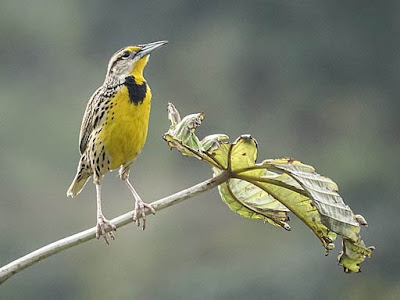 |
|
Eastern Meadowlark
Photo by Mike’s Birds from Riverside, CA, US [CC BY-SA 2.0]
|
The upper parts are streaked black, white, brown, so they blend into the dried grass where they live. The under parts are bright yellow with a black necklace across the chest. Very similar to Western Meadowlark, best told apart by spring song.
These birds live in prairies and extensive pasture lands.
Eastern Meadowlarks are summer residents throughout Michigan.
Yellow-throated Vireo
Vireos are slow moving small birds that sing throughout the day. These yellow-headed vireos are one of the most colorful of their clan.
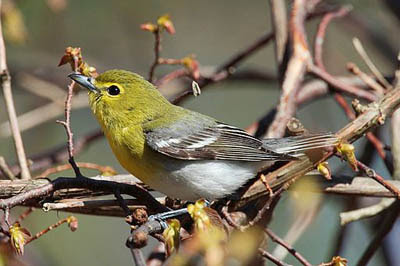 |
| Yellow-throated Vireo. MDF. CC BY-SA 3.0 |
These birds are blue-gray above, white below. Two white wing bars. Their head is olive yellow with yellow spectacles around the eye, and bright yellow throat.
These birds like large tracts of unbroken deciduous or mixed woodlands. Interestingly, however, they are often found on forest edges.
Yellow-throated Vireos are summer residents in the Lower Peninsula of Michigan, nearly absent on the Upper Peninsula of Michigan.
Pine Warbler
These yellow and gray birds are one of the few warblers to visit feeders–and the only one to eat seeds!
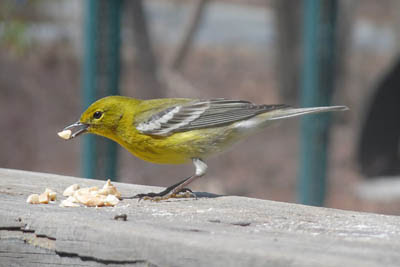 |
| Pine Warbler. Nikolaus Schultz. Pixabay. |
These birds are yellow-green on head, back, and breast. Wings blue-gray with wide white wing bars. Yellow split eye ring.
Strongly associated with pine forests. Usually high in tree tops.
Pine Warblers are summer residents throughout Michigan.
Wrapping Up
Michigan boasts a vibrant collection of feathered friends, many adorned with stunning plumage. Here are some of the most colorful birds you might encounter in the mitten state:
Woodland Beauties:
- Scarlet Tanager: During breeding season, males flaunt a fiery crimson body, black wings, and black wing bars. Look for them in open woodlands and deciduous forests.
- Summer Tanager: Males sport a dazzling plumage with a crimson body, black head, and white wing bar. They favor deciduous forests and woodlands during their spring and summer stay.
- Indigo Bunting: Males showcase a deep blue body with black streaks and a white wing bar. Their high-pitched song adds melody to woodlands and shrubby areas.
- Cedar Waxwing: These bohemian beauties possess silky gray plumage, a bright yellow band across their tail, and a distinctive red wax-like tip on some wing feathers. They’re often seen in flocks, flitting through forests and orchards.
- Eastern Bluebird: Males display a stunning coat of bright blue body feathers, orange breast, and white belly. They prefer open woodlands and fields with nesting cavities.
Backyard Brilliance:
- Northern Cardinal: The male Cardinal is a familiar symbol of Michigan with its vibrant red body, black mask, and pointed crest. They thrive in backyards, thickets, and shrubbery.
- Rose-breasted Grosbeak: Males boast a rosy-red breast, black head, and white wing bars. Look for them in open woodlands, edges of fields, and even backyards with feeders.
- American Goldfinch: These bright yellow finches with black wings and cap are common year-round residents, especially in winter when they visit feeders for thistle seeds.
- Eastern Bluebird: As mentioned earlier, these beauties can grace your backyard with their blue and orange plumage, particularly during winter when they come in search of berries.
- Indigo Bunting: These blue beauties might frequent your feeders during migration periods, adding a dash of color to your backyard landscape.
Open Country Jewels:
- Western Meadowlark: The state bird of Michigan, the Meadowlark exhibits a bright yellow breast, black bib, and white V on its back. Their melodious song resonates across open fields and meadows.
- Bobolink: Males showcase a black and white body pattern with a buffy wing patch and a distinctive white rump. Listen for their bubbling song as they soar over meadows and grasslands.
- Common Yellowthroat: These energetic warblers sport a bright yellow throat, olive-green body, and white wing bars. They flit through low vegetation in fields, marshes, and meadows.
Frequently Asked Questions
What Michigan bird has red body black wings?

Scarlet Tanagers are beautiful summer residents in Michigan, adding a splash of crimson to the state’s woodlands. Finding them requires knowing their preferred habitat and timing your visit when they’re around. Here’s a guide to help you increase your chances of spotting these stunning birds:
Habitat:
- Deciduous forests: Scarlet Tanagers prefer mature deciduous forests with tall trees, especially those dominated by oaks, maples, and beeches. Look for them in the upper canopy layer, where they forage for insects and berries.
- Open woodlands: While they favor denser forests, Tanagers may also use open woodlands with scattered trees, particularly during migration.
- Edges and clearings: Edges of forests and clearings within woodlands sometimes attract Tanagers due to increased sunlight and insect availability.
Timing:
- Late May to early August: Scarlet Tanagers arrive in Michigan in late May and stay until early August. This is your prime window for sightings.
- Early mornings and evenings: These birds are most active during the cooler hours of the day, making dawn and dusk ideal times for observation.
Specific Locations:
- Sleeping Bear Dunes National Lakeshore: The diverse forests and open woodlands within the park offer good opportunities for finding Tanagers.
- Isle Royale National Park: The mature deciduous forests on the island attract many Tanagers during the summer months.
- Pembina State Park: This popular park with its large expanses of deciduous forests provides excellent habitat for Tanagers.
- Hartwick Pines State Park: The old-growth pines and mixed hardwoods here can attract Tanagers seeking suitable nesting sites.
- Local parks and nature reserves: Many parks and reserves with mature deciduous trees can harbor Scarlet Tanagers during their stay in Michigan.
What kind of bird has an orange head in Michigan?
Identifying a bird based solely on an orange head can be tricky, as several species in Michigan sport similar features. To narrow it down, consider additional details like size, body color, beak shape, and where you saw the bird. Here are some possibilities:
- American Robin: Males have a rusty orange breast, but not a true orange head. They’re abundant year-round throughout Michigan and frequent various habitats, including backyards, parks, and woodlands.
- Northern Cardinal: Males have a vibrant red body, including the head, which might appear orange in certain lighting. They’re common year-round residents, thriving in backyards, thickets, and shrubbery.
- Baltimore Oriole: Males have a bright orange body, including the head and neck, with black wings and a white wing bar. They prefer open woodlands, forest edges, and riverbanks, and are common summer residents in Michigan.
- Eastern Bluebird: While not truly orange, males have a stunning blue coat with an orange breast that might appear orange from a distance. They favor open woodlands and fields, and are common year-round residents in Michigan.
How does the Yellow Warbler get its color?
The vibrant yellow plumage of the Yellow Warbler, like the colors of all birds, comes from a fascinating interplay of pigments and structures within their feathers. Here’s a breakdown of how it works:
Pigments:
- Carotenoids: These reddish-orange pigments are responsible for the yellow color in Yellow Warblers. Carotenoids aren’t produced by birds themselves but are obtained through their diet. The Yellow Warbler gets its carotenoids primarily from insects and berries rich in these pigments.
- Melanin: While not directly contributing to the yellow color, melanin plays a crucial role in shaping the overall plumage pattern. Melanin is responsible for darker colors like brown and black, and its distribution in the feathers can influence the intensity and shades of yellow we see.
Feather Structure:
- Keratin: Feathers are primarily composed of keratin, a protein that forms the barbs and barbules that make up the feather vane. The structure of these keratin layers can affect how light interacts with the pigments, further influencing the perceived color.
- Light scattering: The microscopic structure of the keratin fibers in Yellow Warbler feathers can scatter light in a way that amplifies the yellow wavelengths reflected by the carotenoids, thus producing the vibrant yellow hue.
Diet and Genetics:
- The amount and type of carotenoids consumed by a Yellow Warbler can influence the intensity of its yellow plumage. Birds with access to a richer source of carotenoids may have brighter yellow feathers.
- Genetic factors also play a role in determining how efficiently birds absorb and utilize carotenoids, and may contribute to some variations in individual plumage coloration.
Summary:
The Yellow Warbler’s vibrant yellow plumage is a result of a complex interplay between carotenoids in their diet, melanin distribution in their feathers, and the unique structure of their feather keratin. This combination of factors creates a stunning visual display that plays a role in attracting mates and camouflaging themselves in their environment.
Related Articles:
See photos and learn about the most common backyard birds in Michigan, regardless of color.
See photos and learn what to feed winter birds in Michigan.
Birds at your feeder in Michigan
Here’s a quick tutorial of how I would teach you to identify birds: 7 Steps to Identify Birds!
Birds with red heads in North America.
Yellow-and-black birds in North America.










